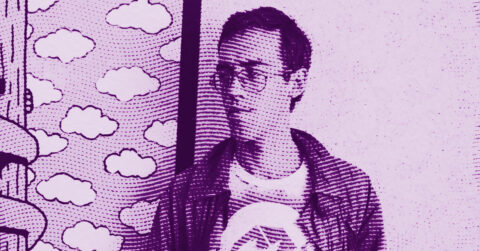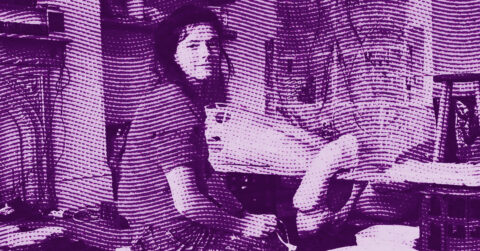Listen to me carefully, you bunch of snobs: you spend your days looking for the extraordinary in contemporary art, when right before your eyes, in the galleries of Yogyakarta as well as those of Venice, an artist has been operating for twenty-five years who transforms the most mundane into the sublime. Handiwirman Saputra, born in 1975 in Bukittinggi, co-founder of the Jendela Art Group, does not produce art to reassure your aesthetic certainties. He creates objects that disturb our relationship to the world, that fracture our perceptual automatisms with the patience of a geologist and the audacity of a conceptual conjurer.
In his workshop in Bantul, near Yogyakarta, Saputra has been manipulating materials of assumed triviality for decades: rubber, synthetic hair, plastic, metal, polyurethane resin. These substances, survivors of our industrial daily life, undergo a metamorphosis in his hands that defies all commercial logic. An elastic becomes a monumental installation several meters high. A piece of pink plastic simultaneously evokes a bodily excrescence and a fragment of a lunar landscape. This alchemy has nothing spectacular about it; it proceeds from a minute observation of what we look at without seeing, of what we touch without feeling.
Saputra’s art is rooted in a philosophy of displacement that finds its deepest echoes in Lacanian theories of the gaze. For this is indeed what it is about: not showing, but structuring a gaze that reveals the unthought of our relation to objects. Jacques Lacan, in his developments on the object petit a, teaches us that the gaze is never neutral, that it is always already informed by the unconscious, deformed by our projections and our lacks [1]. In Saputra’s work, this Lacanian dimension of the gaze finds a striking plastic translation. His sculptures are not objects to be passively contemplated, but devices that reveal the very structure of our gaze, its blind spots, its presuppositions.
When he presents Tak Berakar Tak Berpucuk No. 12 (2011), this rosy and bulbous form that evokes both the organic and the artificial, Saputra implements what Lacan calls anamorphosis: this distortion that is revealed only from a certain angle, that escapes the frontal grasp of the gaze. The work resists immediate identification, it blurs categories, confuses references. This resistance is not gratuitous; it points to something essential in our relationship to objects: their capacity to escape us, to remain other despite our attempts at symbolic appropriation. The Lacanian gaze is never mastery, it is always already traversed by what escapes it, haunted by that blind spot which paradoxically structures its vision.
The scale manipulation in Saputra’s work proceeds from this same logic of perceptual destabilization. His giant rubber bands, his dilated forms create what Lacan would call an effect of Unheimlich, that unsettling strangeness that arises when the familiar suddenly becomes strange. The viewer, confronted with these objects whose scale disrupts their bodilyreference points, physically experiences this disorientation of the gaze that Lacanian psychoanalysis theorizes. Their body becomes inadequate to the object, their gestural automatisms are rendered obsolete. This experience of the disjunction between the eye and the object, between expectation and encounter, constitutes the core of Saputra’s poetics.
The installation Menahan Letakan Di Bawah Sangkutan (2011-2014) perfectly illustrates this dynamic. Covered in pale pink resin and artificial turf, evoking the cross-section of a body or the emergence of an iceberg, the work plays on these zones of indeterminacy where the gaze shifts between subjective projection and objective perception. Lacan reminds us that the object of desire is never the empirical object but this object-cause of desire that structures our relationship to the world. Saputra’s sculptures function precisely as these object-causes: they trigger a dynamic of desire without ever being reduced to their raw materiality. They are there, present, undeniably real, but they constantly point to an elsewhere, to that beyond the object that founds our humanity.
This strategy of displacement also fits within the framework of Viktor Shklovsky’s reflections on the effect of defamiliarization (ostranenie). A theorist of Russian formalism, Shklovsky developed as early as 1917 the idea that art has the function of making the familiar strange, of breaking the automatisms of daily perception [2]. In Saputra’s work, this defamiliarization operates in particularly sophisticated ways. It is not simply a matter of presenting the ordinary in an unusual light, but of creating the conditions for a renewed perceptual experience, a reactivation of our sensory capacities dulled by habit.
The series Toleran Intoleran offers a masterful example of this aesthetics of defamiliarization. Saputra explores the elastic properties of rubber as a metaphor for the limits of human tolerance. But this metaphorical reading, however relevant, should not obscure the artist’s purely formal work. For it is first and foremost through the physical manipulation of the material, through the exploration of its plastic possibilities, that Saputra arrives at his conceptual intuitions. This method, which privileges material experimentation over a priori conceptualization, fits perfectly within Shklovsky’s approach to defamiliarization.
Shklovsky insists that art must “prolong perception” by complicating form, by increasing “the difficulty and duration of perception”. Saputra’s works scrupulously respect this requirement. His hybrid forms, neither entirely abstract nor truly figurative, require sustained perceptual effort from the viewer. They resist immediate recognition, constrain the eye to incessant back-and-forth between identification and destabilization. This formal resistance is not gratuitous obstruction; it aims to reawaken our “feeling of the object”, to make us find again that capacity for astonishment that accustomation has gradually extinguished.
The collaboration with the craftsman Topan, who has accompanied him for more than a decade, reveals another dimension of this aesthetic of defamiliarization. The transition from the model to the final work is never a simple transposition; it involves a constant negotiation with the properties of the material, its resistances, its unexpected suggestions. This working method, which gives a central place to the controlled accident, to the technical surprise, is akin to what Shklovsky calls “creative deformation”. The artist does not entirely master his process; he accepts that the material participates in the elaboration of meaning, that it inflects the initial project according to its own logic.
Saputra’s enigmatic titles also participate in this strategy of linguistic defamiliarization. Tutur Karena (Say Because), Saat Kelakuan Menjadi Bentuk (When Behavior Becomes Form), Saat Bentuk Menjadi Kelakuan (When Form Becomes Behavior): these formulations, with their paradoxical or tautological character, disrupt our interpretive automatisms. They function as plastic kōan, riddles that guide the gaze without ever reassuring it with a stable meaning. This semantic instability forces the viewer to remain in uncertainty, in that zone of indeterminacy where authentic perception can arise.
Saputra’s originality lies in his ability to articulate material defamiliarization and conceptual defamiliarization without ever falling into didactic illustration. His works do not demonstrate a thesis; they create the conditions for an experience that can, potentially, generate thought. This epistemological modesty, this confidence in the intelligence of the viewer, distinguishes his work from many contemporary productions that confuse art and communication. Saputra trusts in the revelatory power of form, in the capacity of objects, when rightly arranged, to teach us something about ourselves and about the world.
When he presents his works at the 2019 Venice Biennale, Saputra confirms this universal dimension of his discourse while claiming his cultural singularity. For if he draws from a Minangkabau imagination (this philosophy of dalam tampak luar, luar tampak dalam, “the inside that looks outside, the outside that looks inside”), he never falls into cheap exoticism. His cultural references nourish his plastic reflection without ever limiting it to an assigned identity. This assumed universality of contemporary Indonesian art, this capacity to speak from its singularity to a shared humanity, constitutes one of the most precious contributions of his work.
The recent evolution of his practice, notably his collaboration with Syagini Ratna Wulan and Asmudjo Jono Irianto for the collaborative installation Lost Verses: Akal Tak Sekali Datang, Runding Tak Sekali Tiba, testifies to an opening towards forms of collective creation that enrich his approach without denaturing it. The smoking room he designs for this work extends his reflection on spaces of sociability, on those intermediate places where our relationships with others and with ourselves are elaborated. This attention to the micro-rituals of daily life, to the infinitesimal gestures that structure our social existence, reveals the anthropological dimension of his work.
For Car Saputra is also, fundamentally, an observer of the human. His enigmatic forms, neither entirely organic nor completely artificial, question our contemporary relationship with nature, technology, and the living. In a world where these categories are becoming increasingly porous, where the boundaries between natural and artificial are blurring, his art offers hybrid forms that perhaps anticipate our forthcoming mutations. This prospective dimension, this ability to sense ongoing transformations before they become visible, makes him an essentially contemporary artist.
At the end of this journey, it is clear that Handiwirman Saputra has invented a plastic language of rare singularity, an artistic idiom that transforms material poverty into perceptual richness. In an art market often obsessed with spectacle, he advocates for an aesthetic of sobriety that has nothing to do with asceticism. His works are generous, sensual, inhabited by a discreet humor that defuses their strangeness. They testify to a rare plastic intelligence, a capacity to think through form that places their author among the most singular voices in international contemporary art. Faced with the decorative and conceptual inflation that characterizes so many current productions, Saputra reminds us that art perhaps begins where our pretension to master meaning ends, where this space of fertile uncertainty opens up where beauty can emerge.
- Jacques Lacan, Le Séminaire. Livre XI : Les quatre concepts fondamentaux de la psychanalyse, Paris, Éditions du Seuil, 1973.
- Viktor Chklovski, “L’art comme procédé” (1917), in Théorie de la littérature, Paris, Éditions du Seuil, 1965.
















